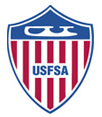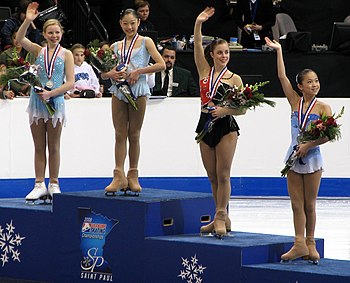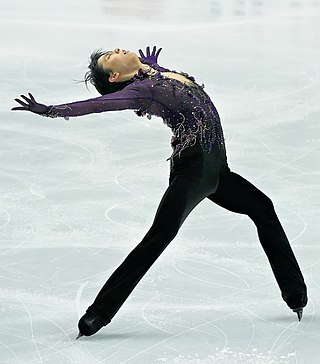
Figure skating is a sport in which individuals, pairs, or groups perform on figure skates on ice. It was the first winter sport to be included in the Olympic Games, with its introduction occurring at the 1908 Olympics in London. The Olympic disciplines are men's singles, women's singles, pair skating, and ice dance; the four individual disciplines are also combined into a team event, which was first included in the Winter Olympics in 2014. The non-Olympic disciplines include synchronized skating, Theater on Ice, and four skating. From intermediate through senior-level competition, skaters generally perform two programs, which, depending on the discipline, may include spins, jumps, moves in the field, lifts, throw jumps, death spirals, and other elements or moves.

The World Figure Skating Championships is an annual figure skating competition sanctioned by the International Skating Union. Medals are awarded in the categories of men's singles, women's singles, pair skating, and ice dance. Generally held in March, the World Championships are considered the most prestigious of the ISU Figure Skating Championships. With the exception of the Olympic title, a world title is considered to be the highest competitive achievement in figure skating.
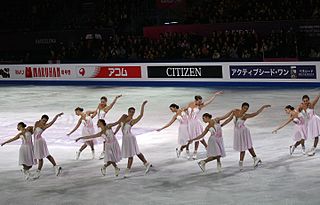
Synchronized skating, often called synchro, is an ice skating sport where between 8 and 20 skaters perform together as a team. They move as a flowing unit at high speed over the ice, while performing elements and footwork.

The International Skating Union (ISU) is the international governing body for competitive ice skating disciplines, including figure skating, synchronized skating, speed skating, and short track speed skating. It was founded in Scheveningen, Netherlands, in July 1892, making it one of the oldest international sport federations. The ISU was formed to establish standardized international rules and regulations for the skating disciplines it governs, and to organize international competitions in these disciplines. It is now based in Switzerland.

Figure skating was first contested in the Olympic Games at the 1908 Summer Olympics. Since 1924, the sport has been a part of the Winter Olympic Games.
The ISU Judging System or the International Judging System (IJS), occasionally referred to as the Code of Points (COP) system, is the scoring system that has been used since 2004 to judge the figure skating disciplines of men's and ladies' singles, pair skating, ice dance, and synchronized skating. It was designed and implemented by the International Skating Union (ISU), the ruling body of the sport.
A figure skating club is a local organization of figure skaters, often centered on a single ice rink. Typical club activities include arranging practice ice time, hosting test sessions and competitions, and producing an annual ice show in which club skaters may take part. Some clubs also emphasize non-skating social activities.
The Skating Club of Boston is a not-for-profit figure skating club based in Norwood, Massachusetts. Founded in 1912, it is one of the oldest skating clubs in the United States, and a founding member of U.S. Figure Skating, the governing body for the sport in the United States. The Club's mission is to advance participation, education and excellence in skating for people of all ages, abilities and means. The Club has over 800 active members and offers a variety of programs for the public, reaching another 2,000 children and adults. The club built its own rink in Brighton, Massachusetts in 1938 and remained there until moving to the Norwood facility in 2020. In addition, in a public private partnership with the City of Boston's Parks & Recreation Department, the Club manages the programming and facilities for The Frog Pond located at Boston Common on a year-round basis.

The Philadelphia Skating Club and Humane Society is the oldest figure skating club in the United States.
A figure skating competition is a judged sports competition in figure skating.
Adult figure skating is a term used by skating organizations to refer to tests and competitions for amateur ice skaters over 21. The category was originally aimed at skaters who had taken up the sport as adults, but more recently has expanded to include adult skaters performing and competing at an 'elite' level, many of whom had skated competitively as children or adolescents. Adults who are learning to skate without prior experience are also included. In addition, a "Young Adult" category has been added to many Adult events.
The International Skating Union organizes six annual Championships for figure skating. It is at the discretion of each member country which skaters, pairs or synchronized skating teams are sent to which championship.
The U.S. Synchronized Skating Championships is an annual synchronized skating competition, sanctioned by U.S. Figure Skating, held to determine the national champions of the United States. It was first held in 1984. Teams who qualify at a Sectional Championship competition compete in eight levels: juvenile, intermediate, novice, junior, senior, collegiate, adult and masters. The top two senior teams then go on to compete at the World Synchronized Skating Championships, while at the Junior level the teams competing at the World Junior Synchronized Skating Championships is predetermined by a Junior World Qualifier competition. The teams competing at the Junior Level at the U.S. Synchronized Skating Championships are competing for international assignment for the next years.

The Haydenettes are a senior-level synchronized skating team representing The Skating Club of Boston in Norwood, Massachusetts, United States. They are five-time bronze medalists at the World Synchronized Skating Championships, earning the title in 2010, 2011, 2012, 2013, and 2016. Formed in 1979 by Lynn Benson, the Haydenettes are the most successful synchronized skating team in U.S. history, with 30 U.S. National titles.
The U.S. Collegiate Figure Skating Championships, are a collegiate figure skating competition sanctioned by U.S. Figure Skating. It is the highest level at which figure skating takes place at the college level in the United States. The event has been held since 1986. The event takes place in August of the calendar year, and generally at the beginning of the figure skating season.
The Essex Skating Club is a figure skating club based at Richard J. Codey Arena in West Orange, New Jersey. The club has teams and over 300 skaters who compete in many national competitions.
The 2019 GEICO U.S. Figure Skating Championships were held from January 18, 2019 – January 27, 2019 at the Little Caesars Arena in Detroit, Michigan. Medals will be awarded in the disciplines of men's singles, ladies singles, pair skating, and ice dancing at the senior, junior, novice, intermediate, and juvenile levels. The results will be part of the U.S. selection criteria for the 2019 Four Continents Championships, 2019 World Junior Championships, and the 2019 World Championships.
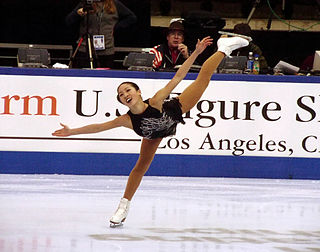
Figure Skating is a sport in which individuals, pairs, or groups perform on figure skates on ice. Although ice skating began in 3,000 BCE in Scandinavia, American Edward Bushnell's 1855 invention of steel blades and Jackson Haines bringing elements of ballet to figure skating were critical to the development of modern-day figure skating. Since then, figure skating in the United States has grown to have 186,038 members as of the 2020–2021 season.
Andrew "A. J." Sass is an American author of children's and young adult fiction, best known for his middle grade contemporary novel, Ana on the Edge, and his Time op-ed discussing transgender and non-binary character representation in youth literature.
The 2023 European Figure Skating Championships were held from 25 to 29 January 2023 at the Espoo Metro Areena in Espoo, Finland. Medals were awarded in men's singles, women's singles, pair skating, and ice dance. The competition determined the entry quotas for each skating federation at the 2024 European Championships.

